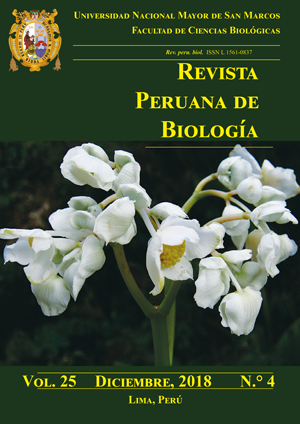Association of mercury resistance with resistance to antibiotics in Escherichia coli isolated from the coast of Lima, Peru
DOI:
https://doi.org/10.15381/rpb.v25i4.14312Keywords:
Escherichia coli, resistance to mercury, resistance to antibiotics, conjugation of plasmids, Humboldt Current System.Abstract
The Lima coast is highly affected by anthropogenic effluents from wastewater from contaminated urban rivers that flow into the coast. The objective of this study was to investigate the resistance to mercury and antibiotics, and the transfer of resistance to mercury by conjugative plasmids in 55 strains of Escherichia coli isolated of surface seawater from coastal Lima, Peru. The Minimum Inhibitory Concentration (MIC) was determined for various antibiotics and for mercury in the isolated strains. To confirm the plasmid resistance to mercury, the curing was carried out with 10% sodium dodecyl sulfate (SDS). The plasmid transfer assay by conjugation was performed using the E. coli DH5α as recipient strain only with the strains that showed sensitivity to mercury after curing. The extraction of the resistance plasmids was carried out only in the transconjugant strains resistant to mercury. 41 (74.5%) strains were resistant to mercury (HgR), with MICs between 30 μM (8.25 ppm) and 300 μM (82.5 ppm), of these, 33 were HgR by plasmids and of this last group, 14 were also resistant to antibiotics. Only 6 strains had conjugative plasmids with mercury resistance, showing a transconjugation frequency between 9.41x10-4 and 4.76x10-2%. The high prevalence of HgR in E. coli strains isolated from the coast of Lima could be a public and environmental health problem. In this sense, congugative plasmids can contribute to the spread of mercury and/or resistance to antibiotics among bacterial communities in marine environments.Downloads
Downloads
Published
Issue
Section
License

This work is licensed under a Creative Commons Attribution-NonCommercial-ShareAlike 4.0 International License.
AUTHORS RETAIN THEIR RIGHTS:
a. Authors retain their trade mark rights and patent, and also on any process or procedure described in the article.
b. Authors retain their right to share, copy, distribute, perform and publicly communicate their article (eg, to place their article in an institutional repository or publish it in a book), with an acknowledgment of its initial publication in the Revista Peruana de Biologia.
c. Authors retain theirs right to make a subsequent publication of their work, to use the article or any part thereof (eg a compilation of his papers, lecture notes, thesis, or a book), always indicating its initial publication in the Revista Peruana de Biologia (the originator of the work, journal, volume, number and date).






